Check out my custom vibration dampener
adidas SoleCourt Boost
In-depth Review & Playtest
We hope you love this article. Just so you know, TennisCompanion may collect a small share of sales from the links on this page to help keep this site running. Learn more.
If style and performance are high priorities when buying your next pair of tennis shoes, look no further than the adidas SoleCourt Boost.
Worn by top ATP & WTA players, including Dominic Thiem, Stefanos Tsisipas, Angelique Kerber, and Garbiñe Muguruza, they’re one of our picks for the best tennis shoes in 2020.
Of course, like any pair, they aren’t for everyone, and they come with their own set of downsides. In this review of the SoleCourt Boost, I dive deep and share my thoughts to help you decide whether they’re a good fit or if you should pass and keep looking.
Article Contents
Click below to jump to a section
Tap below to jump to a section
Video Review & Playtest
SoleCourt Boost Unboxing
About the SoleCourt Boost
Fit & Players Using
Review & Playtest Notes
Summary
New to TennisCompanion?
Create a free account and explore my latest videos below
Video Review & Playtest
Want to see the adidas SoleCourt Boost in action? Check out my video review and playtest, where I share everything you need to know about their features along with my unbiased thoughts on their performance.
Below I’ve included timestamps for the different sections of the video so you can quickly jump around or reference a specific part in the future.
Feature Overview
0:36 – Feature Start
0:56 – Weight & Fit
1:23 – Outsole
1:56 – Midsole
2:23 – Upper
Playtest & Review
3:04 – Playtest Start
3:35 – Style
3:52 – Lacing
4:13 – Comfort
4:43 – Stability
5:04 – Traction
5:17 – Durability
5:35 – Weight
5:48 – Ventilation
6:05 – Summary
Keep reading to learn more about the adidas SoleCourt Boost and check out my detailed notes on my review and playtest.
adidas SoleCourt Boost Unboxing & Initial Impressions
For my review and playtest, I’ purchased the adidas SoleCourt Boost in black with orange highlights.

As a point of reference, I’m a US men’s size 10.5, which I stuck with for this review and adidas translates to the following:
- F 44 2/3
- UK 10
The box is black with three white stripes, and Boost comes printed along the side in bold yellow letters. You’ll also find the word Boost written in a diagonal pattern across the black sections of the box for a subtle touch.

When I first opened the box, one of the things that stood out to me was the color of the adidas stripes and logo at the heel of the shoe.
In many photos online, they appear yellowish gold, but they’re bright orange, and although it’s not my favorite color, it’s fitting.
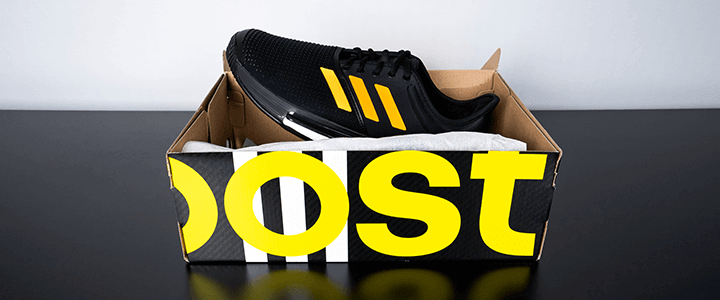
The upper looks great, particularly up around the heel, where the material is smooth, has a light sheen, and feels ultra-premium.

The protective RPU dots along the forefoot give the shoes a distinct look, which I could see being a bit offputting to some players. I like how they’re more subtle on the black version.
The 3-D molded foam ankle collar gives the back of the shoes a unique look, which I have to admit wasn’t my favorite when I first came across them, but over time it grew on me.
Overall, I think the shoes have a stealthy look that shows much better in person than in photos online.
About the adidas SoleCourt Boost
Released in January 2019, the adidas SoleCourt Boost was perhaps the closest alternative for longtime fans of the Barricade, which after nearly two decades, didn’t receive an update last year and won’t in 2020.
Of course, the SoleCourt Boost is an entirely new concept and not meant to replace the Barricade, which adidas has suggested they’re revamping and will release in the future.
With that said, the adidas SoleCourt Boost is currently one of their flagship high-performance tennis shoes worn by ATP and WTA tour athletes and intended to stand up to the demands of advanced players, while also serving as an excellent option for beginners and intermediates.
Outsole

For the outsole, the SoleCourt Boost features durable Adiwear rubber and makes use of a herringbone style tread.
Up toward the front on the inside or medial edge, you’ll notice the tread is a bit thicker for added durability in that high impact area.
The outsole wraps up the front of the shoe for a generous toe guard and extends through the inside front edge for added protection, which I always appreciate helping with the longevity of the shoes.
At the heel, you’ll notice the outsole has a subtle slope or angle for a more natural heel to toe transition when stepping.
Overall, the grip is solid with the outsole feeling a little softer than most, and although there is a clay court model available, this tread pattern will work great on hard courts and transition well to clay courts.
Midsole

You’ll find Adidas Boost technology for comfort at the midsole, which is the white textured material that you can see at the side of the shoe.
If you’re not familiar with Boost, it’s hundreds or, in some cases, thousands of small plastic TPU particles that expand under heat to form closed cells around tiny air pockets.
The result is a resilient material that absorbs shock while returning energy to the player with every step.
For stability, the shoe features a semi-rigid foot frame, which is the black layer that rides just above the Boost midsole and connects with the midfoot shank at the bottom of the shoe.
Upper

The upper offers comfort and style with premium synthetic materials.
Around the forefoot, Adituff Rigid Polyurethane (RPU) dots blanket the shoe to provide abrasion resistance. Toward the toe, the protective dots become larger and tighter together and eventually meet up with a toe cap at the front of the shoe.
At the back of the shoe, there’s a rigid heel counter for stability, and a 3-D molded foam ankle collar helps offer a locked-in feel.
On the inside of the shoe, the material is unique. When you slip your foot into the shoe, it’s smooth. However, once your foot is in place, it offers a bit of grippy resistance to help keep your heel planted.
Last but not least, the shoes offer a standard tongue with a bit of stretch, and it doesn’t bunch up when lacing them. Metal eyelets allow you to synch the shoes tight with confidence.
Insole

The adidas SoleCourt Boost offers a relatively standard insole. It’s on the thinner side and nothing special, but it does the trick. When removed, the mold of the insole showcases the medium-high arch.
Variations of the adidas SoleCourt Boost
Even though the adidas SoleCourt Boost first hit the market in 2019, there has been a bit of variety they’ve introduced.
For starters, they’ve come out with numerous colorways, which I always appreciate. Some are harder to find than others at this point, but there aren’t any signs of stopping, so it’s worth keeping an eye out for the latest releases if you’re looking for something fresh.
adidas SoleCourt Boost Parley
Other than that, you’ll find a few versions of the shoe that integrate Ocean Plastic from a cool organization named Parley, which upcycles marine plastic debris to create material for a variety of products.
Functionally, the shoes are identical while supporting a great cause.
Fit and Players Using
Like the Barricades that came before them, the adidas SoleCourt Boost features a roomy toe box and run slightly large.
They’re not large enough to warrant dropping down a size, but you’ll have a bit of extra room up front. I didn’t have any issues with the extra space, but it’s noticeable, and if your feet are narrow, you’ll likely be turned off by the fit.
As for arch support, they’re medium-high. I have pretty standard feet when it comes to arches, and it didn’t phase me at all. Of course, if you’re sensitive to higher arches, it’s worth keeping in mind.
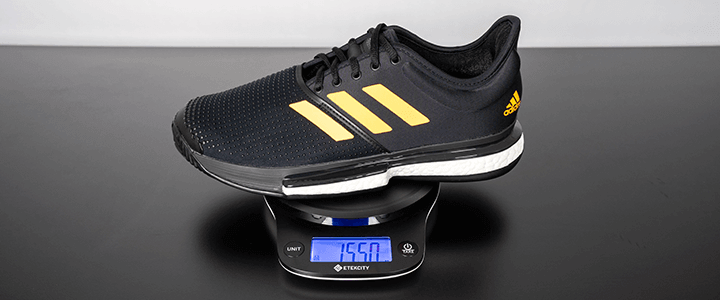
SoleCourt Boost Specs
| Size | Slightly large |
| Width | Medium-high |
| Arch Support | Medium |
| Men’s Weight | 15.5 ounces @ size 10.5 |
| Women’s Weight | 13.5 ounces @ size 7.5 |
| Break-in | None required |
Top Players Using the SoleCourt Boost
| Men | Women |
| Dominic Thiem | Angelique Kerber |
| Stefanos Tsitsipas | Garbiñe Muguruza |
| Borna Coric | Andrea Petkovic |
SoleCourt Boost Review & Playtest Notes
Whenever I run a playtest, it’s my goal to push the shoes in various scenarios to gain the most comprehensive understanding of their performance.
For this review, I took the adidas SoleCourt Boost on a two-mile coast run to gain a feel for the shoes’ comfort and weight. I also worked through a variety of agility and footwork drills to better understand their traction and stability.
Finally, I spent hours playing tennis on the court over two weeks to gauge their overall performance and form the basis of this review.

In the sections that follow, you’ll find my ratings of the shoes on a variety of criteria along with notes summarizing my thoughts.
Style 9.4
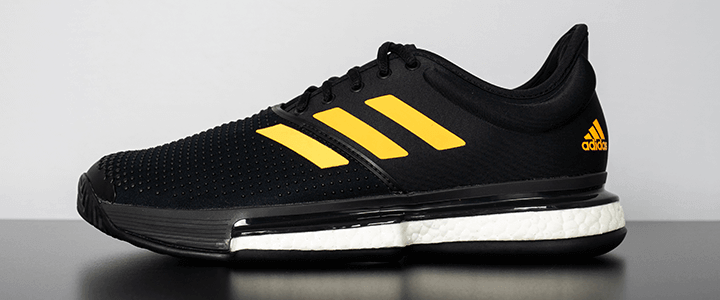
When it comes to style, the adidas SoleCourt Boost is one of my favorite tennis shoes. The materials used for the upper look and feel great, and they have a sleek profile.
I love the black colorway, and although they’re certainly not intended for daily wear, it’s one of the few tennis shoes that I think looks good on and off the court – especially when compared to some other models out there like the Asics Court FF 2, which feel out of place off the court.
Lacing 8.9
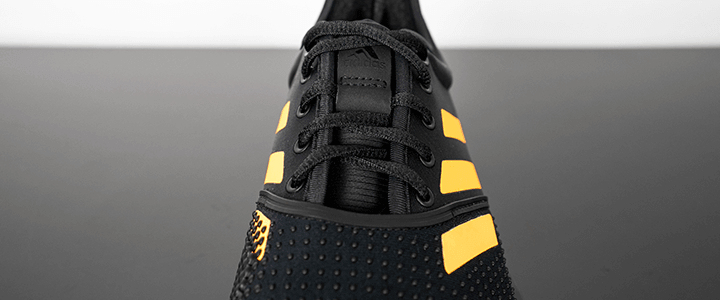
As far as lacing goes, it’s smooth and easy.
The tongue has some nice stretch to it, and it doesn’t bunch awkwardly. Plus, the metal eyelets allow the standard laces to pull through easily to achieve a snug fit without worrying about breaking an eyelet.
That might sound hard to do, but some players have experienced this issue with their lower-end models like the adidas CourtJam Bounce.
The only downside I stumbled across with lacing is replacing them if they break. A portion of the laces hide underneath the upper’s fabric, and there are two small loops you have to thread the laces through to help keep the forefoot snug, which can be a bit cumbersome.
It’s not a significant issue, but it’s hard to tell from any photos, so worth mentioning.
Comfort 9.2

In terms of comfort, the adidas SoleCourt Boost is excellent. Here are a few of the primary criteria I use to help gauge comfort:
- Shock absorption
- Form-fit
- Pressure points
Shock Absorption
The Boost midsole does most of the heavy lifting when it comes to shock absorption, and true to the claims, they provide a super comfortable ride that’s responsive, so my movement never felt hindered.
After each session on the court, my legs felt great, and I thought they were plenty comfortable on my two-mile coast run.
Form-Fit
As far as fit goes, the shoes do run a bit large, and they’re slightly wider up in the toe box, but honestly, I didn’t feel like I was swimming in them or wearing the wrong size.
It may take getting used to coming from a brand like Nike, which tend to fit snug as is with the Vapor X, but I didn’t have any issues with this.
If the extra room is problematic for you, make sure you synch the laces tight up toward the front. You may also consider wearing an extra pair of socks to fill out the shoes a bit more.
Pressure Points
I’m always on the lookout for awkward pressure points that can become problematic, but there weren’t any that I could detect over my two-week testing period, which gives me confidence in saying there is no break-in period required for these shoes.
Stability 8.8
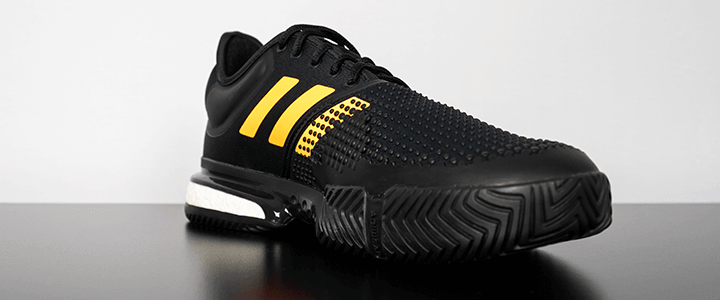
As far as stability goes, the adidas SoleCourt Boost was solid.
They offer a wide base at the forefoot for excellent balance, and I was able to move through all of my agility and footwork drills with confidence.
Throughout my playtest, there was only one point at the baseline where I felt my ankle collapse slightly as a result of some poor footwork on my part. Luckily it wasn’t a recurring theme, but it happened, so I wanted to take note of it. Other than that, I felt like these shoes were super stable.
Traction 9.1

When it comes to traction, I didn’t have any issues.
They offer top-notch grip to provide sure footing for quick starts and stops. Early in my playtest, the shoes provided virtually no give when stopping, but they started to loosen up a bit in the second week of hitting with them as the outsole began to break in.
Durability 9.0
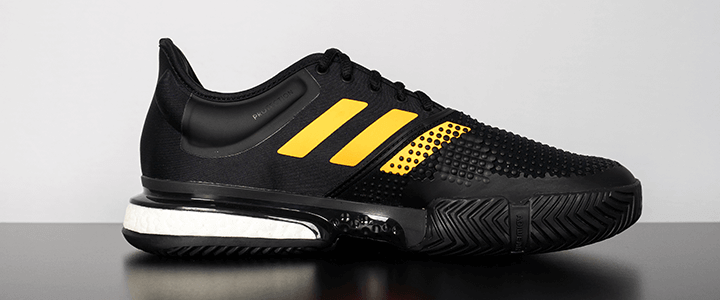
From a durability standpoint, the adidas SoleCourt Boost is fantastic.
The outsole held up super well, and there’s plenty of protection upfront to defend against toe-drags, so I expect these shoes to go the distance.
As for the upper, I questioned the efficacy of the RPU dots at protecting against brushes and scapes, but they appeared to hold up well, so there were no issues to report.
Weight 8.5

When it comes to weight, the SoleCourt Boost tip the higher end of the scales, but they didn’t put a noticeable drag on my movement.
They’re certainly not the fastest shoes out there, but unless that’s a high priority for you, I don’t think their weight should be a concern.
Ventilation 8.3

Perhaps one of the shoe’s most significant weaknesses comes with ventilation as there’s not much offered in terms of breathability or airflow to allow heat to escape.
When combined with the black colorway, the shoes tended to get a bit warm when the sun was out on a hot day, so I’d consider opting for a lighter colorway if you’ve had issues with overheating.
Summary

All in all, the adidas SoleCourt Boost is one of my favorite tennis shoes that deliver excellent comfort, stability, and durability in a stylish package.
They’re on the heavier end of the spectrum, and they could be better ventilated, but they do just about everything else extremely well, so they’re high on my list of shoes to consider and well-worth checking out if you’re in the market for a new pair.
Pros
- Comfort
- Stability
- Durability
Cons
- Weight
- Ventilation
Minor Criticism
The SoleCourt Boost has a wider toebox, which has been a complaint when it comes to adidas tennis shoes in the past. To help with this, I’d love to see them throw an additional set of eyelets toward the forefoot so that players could achieve a tighter fit.
There are two fabric loops the laces pull through toward the front of the shoe, but their impact on achieving a tight fit is limited.
Wrapping Up
Every pair of tennis shoes has its upsides and downsides, but when it comes to the SoleCourt Boost, adidas has produced what I’d consider a winning formula that makes them some of the best shoes on the market.
If you’re in the market for a new pair of tennis shoes and considering the SoleCourt Boost, I hope this resource helped provide some guidance on whether they’re right for you or not.
If you have experience with these shoes yourself, I’d love to hear your perspective in the comments below. Of course, if you have any follow up questions – please don’t hesitate to ask.
Play Better Tennis
Improve your game alongside our community of tennis players
Why join?
Discussion Boards
Join the conversation with other members of the community.
5 Point Friday
Read our weekly recap of the 5 most interesting things we dig up in tennis.



Leave a Reply
Want to join the discussion?Feel free to contribute!